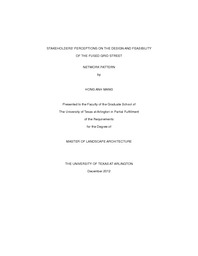
ATTENTION: The works hosted here are being migrated to a new repository that will consolidate resources, improve discoverability, and better show UTA's research impact on the global community. We will update authors as the migration progresses. Please see MavMatrix for more information.
Show simple item record
| dc.contributor.author | Mang, Hong Anh | en_US |
| dc.date.accessioned | 2013-03-20T19:11:59Z | |
| dc.date.available | 2013-03-20T19:11:59Z | |
| dc.date.issued | 2013-03-20 | |
| dc.date.submitted | January 2012 | en_US |
| dc.identifier.other | DISS-11943 | en_US |
| dc.identifier.uri | http://hdl.handle.net/10106/11573 | |
| dc.description.abstract | The fused grid is a newly developed street network pattern for laying out neighborhoods and districts (Grammenos 2002). It uses the fusion of two traditional North American street designs: the traditional nineteenth-century grid and the conventional curvilinear pattern of looped streets and cul-de-sacs utilized in modern suburbia (Grammenos 2004). In the twenty-first century, two cities in Canada -- Calgary, Alberta and Stratford, Ontario -- adopted this model for their neighborhoods. The site in Calgary have been adopted, implemented and is currently under construction. The site in Stratford have been adopted but not implemented. Although the two sites adopted ideas and concepts, there is little reported in the scholarly literature about the design and feasibility of the fused grid.This research assessed the opinions of design and planning professionals and other experts on the design and feasibility of the fused grid street network pattern. The research specifically focused on the design of the fused grid and how it affects the physical realm, as well as its feasibility and adaptation. The research used qualitative research methods and included in-depth telephone interviews (Taylor and Bogdan 1984). The research also benefited from case study documentation techniques (Marcus et al 1998) as well as the review of relevant literature and secondary data. Snowball sampling (Castillo 2009) was used to select design and planning professionals and experts to interview. Data are analyzed using the grounded theory approach (Taylor and Bogdan 1998). The results illustrate that most interviewees find the fused grid design promising because of the advantages it offers such as pedestrian connectivity and proximity to open spaces. However, interviewees believe that it may have limited feasibility because existing case studies are too new to yield a sufficient result in terms of economic investment. Nevertheless, interviewees also suggest that the fused grid is an excellent model for any city to adopt because it provides many benefits and reduces dependency on automobiles for short distance trips. The topic is significant to landscape architecture, because the fused grid offers opportunities for design and planning professionals to be involved in the early process of land planning, opening doors to allow innovative design of storm water management, linear parks that connect one cul-de-sac to another, as well as other green space infrastructures. | en_US |
| dc.description.sponsorship | Ozdil, Taner R. | en_US |
| dc.language.iso | en | en_US |
| dc.publisher | Landscape Architecture | en_US |
| dc.title | Stakeholders' Perceptions On The Design And Feasibility Of The Fused Grid Street Network Pattern | en_US |
| dc.type | M.L.A. | en_US |
| dc.contributor.committeeChair | Ozdil, Taner R. | en_US |
| dc.degree.department | Landscape Architecture | en_US |
| dc.degree.discipline | Landscape Architecture | en_US |
| dc.degree.grantor | University of Texas at Arlington | en_US |
| dc.degree.level | masters | en_US |
| dc.degree.name | M.L.A. | en_US |
Files in this item
- Name:
- Mang_uta_2502M_11943.pdf
- Size:
- 4.564Mb
- Format:
- PDF
This item appears in the following Collection(s)
Show simple item record


